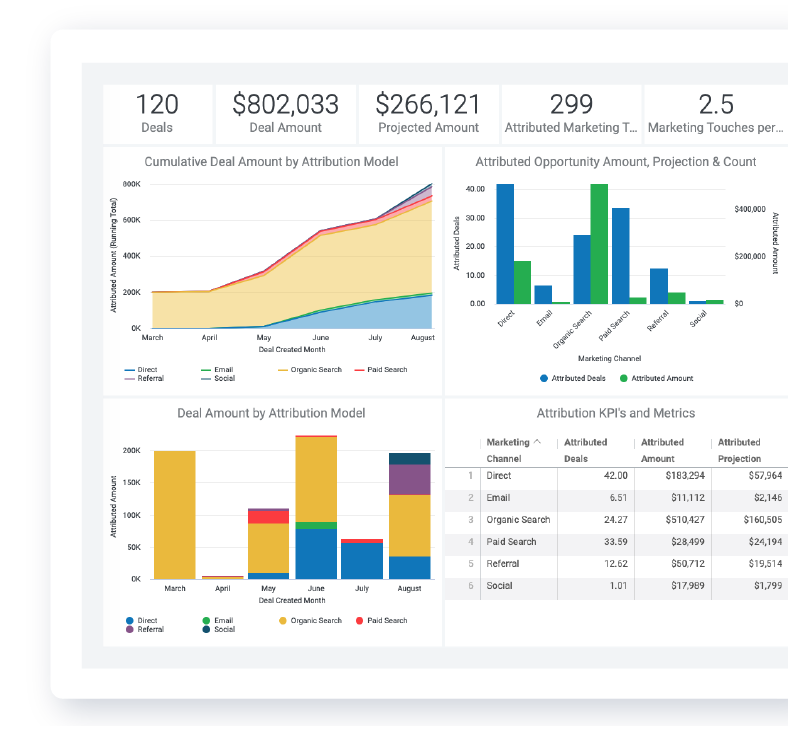Marketing Attribution
By embracing DemandJumps approach to SEO, we have been able to increase our organic rankings within just 2 weeks of implementing recommendations. This helped us see a 22% increase in organic search month-over-month.
Robert Jacko Vice President Digital Marketing @ Homage
DemandJump has become a crucial extension of our marketing team, providing game changing insights to fuel and propel all aspects of our digital marketing efforts. The DemandJump platform is a must have, we are seriously impressed.
Tim Lavinder Director of Ecommerce @ Hotsox
We used to spend hours looking for insights in dozens of tools and reports. Now we log into one place to find out what customers are doing and how to meet them where it matters most.
Zach Roop Digital Marketing Manager @ Dometic
We use DemandJump recommendations as our digital to-do list. We love going in and seeing the recommendations and knowing what to do next.
JoLynda Wilson Marketing Director @ IWC
Our Customers Love Attribution






Account-Based Attribution
Eliminate wasted time and spend. With DemandJump's automated account-based attribution
solution you will know with certainty which efforts are driving ROI.
Measure Your Marketing Performance
Find out which of your marketing efforts are making the biggest impact. See which channel drove consumers to you, the pages they visited, and all touchpoints along their path to purchase.

From Marketing Spend to Actual Pipeline Value
When a lead becomes a customer, you need to know which marketing channel or campaign should receive credit, and account-based attribution will give you the answers.

Organic & Paid Search Keyword Attribution
Beyond channel, campaign, and content attribution, you will finally see which organic and paid keywords are generating deal and opportunity revenue.

See a Demo of Attribution
Sales Opportunity Attribution
Attribution modeling is a powerful analytical framework that helps you understand what marketing touchpoints should be credited for a sales conversion.
Attribution model definitions
What is an attribution model? It’s a system that evaluates each of the marketing touchpoints that consumers intersect with on their way to making a purchase. The goal of a successful attribution model is to better understand the messages and channels that had the biggest impact on whether a consumer chose to buy.
When an attribution model works best, it helps your business understand how customers interact with marketing messages, when those interactions occur, and where (which channel) they happen. Doing so allows marketers and brand managers to adjust campaigns and messages so that they are meeting the demands and needs of customers as well as informing budgets.
Marketing attribution models help you answer critical questions, including:
- What channels and what messages did a consumer come in contact with?
- What actions were taken as a result of those interactions?
- What touchpoints had the most impact on a customer’s decision to make a purchase?
- Which touchpoints did not have an impact?
- What channels were most and least effective in driving customer actions?
- What messaging delivers the best results or customers or groups of customers with shared demographics?
In the end, attribution modeling allows your company to measure the ROI of marketing efforts and reallocate for future campaigns.
Conversion journeys are complex and not always evident. They require marketers to develop informed hypotheses and expectations that are not always immediately clear.
It’s the attribution problem. The challenge is determining who gets credit for the sale. How can you assign value to each touchpoint that a customer might have before making a purchase?
That’s the fundamental challenge for advertising and marketing teams. And it’s why attribution models are necessary.
Why Use Attribution Models?
Are you thinking that using an attribution model is a daunting task and wondering whether it’s all worth it?
Consider some of the major benefits to creating and using an attribution model.
- Smarter Spending. With marketing attribution, you’ll have a much clearer idea of where the money is being spent that drives the most engagements and sales. You’ll have a stronger ROI on your marketing technology stack and be able to demonstrate more effective results to clients.
- Better Campaigns. With more clarity about the ads, campaigns and messages, you can refine the way you market products and services, resulting in more effective campaign planning and execution.
- Enhanced Personalization. With a better understanding of the models that drive engagement, you can personalize the messages and channels that drive better results for individuals or groups of prospective customers.
- Improved Products. Understanding what people want in the products and services your clients are selling allows for improved creation of goods that people want, new market opportunities and revisions to existing products that customers are seeking.
- Campaign Influence. Complex marketing approaches often mean there are multiple campaigns that result in a transaction. By tracking the attribution of multiple strategies, campaign influence measures can better reflect the impact of a multi-campaign approach.
Attribution Models Defined
There are various models available for marketing attribution, sometimes referred to as customer attribution. Each model values different aspects of the interaction differently. Understanding the types of attribution models, their advantages and disadvantages can help you decide which model works best for your business.
There is no one “correct” attribution model. Instead, businesses should complete attribution model comparison analysis to find the model that best fits their marketing strategy, desired outcomes and business goals. Buying cycles, customer characteristics and marketing campaign types can shape which attribution model is best.
Attribution model comparisons are effective in determining which will provide the insights and identify how to best allocate resources to future marketing efforts.
There are multiple attribution models available for your marketing team. Here’s a closer look at the most popular models and the advantages and disadvantages of each type.
Single-Touch Attribution Models
These are among the simplest models and are designed to attribute conversion credit to one action and one message. Under first-touch attribution, the model assumes that a customer chose to make a purchase based on the first message or advertisement they saw. With the first-touch attribution model, all attribution is applied to this message, no matter how many subsequent messages the customer saw or interacted with.
Similarly, the last-touch attribution model (also known as last-click attribution) gives full credit to the last message or advertisement that a consumer saw before completing a purchase. It gives no attribution credit to any prior messages or ads that a consumer may have seen.
The advantage of the single-attribution models is their simplicity. Consumers interact with brands and messages across different devices, can clear cookies and use multiple browsers to view messages. By pinpointing the attribution to a single message, it provides brands with some definition and causality.
However, there’s a downside. In the first-touch attribution model, for example, it disregards every other ad that’s part of a campaign or whether a subsequent message was the thing that caused the customer to act. It’s the same for the last-touch attribution model or last-click attribution model, which disregards everything that came previously.
There’s a variant on the last-click model – the last non-direct click attribution model. It still assigns all credit to one interaction, in this case the last channel a customer through before making a purchase. It’s a helpful benchmark to use when comparing results with other models.
Multi-Touch Attribution Models
While the single-touch model assigns all credit to one marketing channel, the reality is that most campaigns use a multi-channel approach to marketing. It recognizes that multi-channel attribution is the primary construct for many marketing campaigns and that marketing teams want to quantify the impact of each phase of those campaigns accurately.
There are several multi-touch attribution solutions available. Here’s a look at some of the most-used multi-touch attribution models.
The linear attribution model is a different approach that is still relatively simplistic in design. With the linear attribution model, you split credit evenly across all the interactions a customer has with your business.
If a customer finds your brand on Facebook, for example, signs up for an email mailing list and then visits your site directly to make a purchase, each channel is credited equally. For a $150 purchase, a third, or $50, is credited each to the Facebook campaign, the email marketing efforts and the website.
It provides a much more balanced approach to your comprehensive marketing strategy. But it fails to weight which marketing tactics are more effective than others. Still, it’s an advantageous approach to showing clients the impact of each component of your marketing strategy. It’s a straightforward approach that clearly articulates the role multiple channels play in securing sales.
Variants on the linear attribution model include:
- U-shaped attribution. This model is more subjective, recognizing that some touchpoints are more effective than other in driving sales. The model calls for both the first and last touches to be credited with 40 percent of the influence on a sale. The other components split the remaining 20 percent evenly. In our $150 sale example, the Facebook campaign and website would each get $60 in credit with the email marketing credited for $20 of the purchase. It’s a good model for businesses that have multiple touchpoints prior to a sales conversion, giving at least some credit to each interaction. But the most weight is given to the points that are considered the most important – the first time a customer interacts and the interaction that leads to a sale.
- Time decay attribution. Under this model, more weight is given to customer activities that occur closer to the purchase action. The assumption is that those actions that are nearer to a purchase had a greater influence on the consumer’s decision-making than those that happen earlier in the sales funnel. This model is helpful for sales processes that are relationship-driven, requiring more time invested in establishing a rapport with a customer. It’s effective for those processes that take a long time to complete, but can diminish those activities that occur at the top of the sales funnel.
- W-shaped attribution. Like U-shaped attribution models, the W-shaped attribution approach distributes weights unevenly. Here, three key touchpoints each receive 30% of credit – the first touch, the lead conversion and the opportunity creation. The remaining 10 percent is spread evenly among other touchpoints.
No matter which of the multi-touch attribution solutions you use, you will better reflect the layered, sequenced approach to most contemporary marketing campaigns.
Data-Driven Attribution Models
The growth of online advertising, especially related to search engine queries, has led to a new attribution approach. Google has been the driver behind a data-driven attribution model that uses conversion data based on ad purchases to quantify your customer engagement.
The data-driven attribution model looks at every click from a Google search ad. It then compares the patterns taken by consumers who convert to customers to the patterns of those who do not. Google analyzes which of those interactions yields better conversion rates and gives more credit to the relevant ads.
The result is a much clearer way to evaluate conversions and understand which ads have the most impact.
Custom Attribution Models
Some marketers find they need to develop their own customized attribution model to accurately reflect the nuances of the marketing campaign or funnel you’re testing.
Custom attribution models allow you to put the percentages, weights and valuations around each campaign or funnel. However, it can be a challenge to create and, often, these models require lots of data. Businesses with long purchasing cycles and extensive data available are best suited for a customized approach.
Creating Your Marketing Attribution Model
How can you begin to develop your own marketing attribution model? Start with a clear understanding of what marketing activities you’re planning to measure, when those activities occur, and why you are measuring them.
Next, make sure you’ve completed each of these steps.
Step 1 - Identify the Funnel Stages
Funnel stages are the framework of any marketing attribution approach. They show how you move leads through the sales funnel towards a purchase. Typically, your funnel stages would include:
- Lead (Someone who becomes aware of the product or service)
- Interest (A prospect who is actively seeking information that helps them solve a problem)
- Qualified Lead (Determined by either marketing or sales teams based on meeting target customer criteria or exhibiting specific interest in your products or services)
- Committed (Leads who have had red flags and concerns answered and been presented with a proposal)
- Transaction (The final stage when a lead commits and makes a purchase)
Lead attribution is often at the core of marketing attribution strategies, given that different channels and tactics are used for each funnel stage.
Step 2 - Establish Goals
Why are you running your current marketing campaign? Is it to increase sales, raise brand awareness or improve brand reputation? The market attribution model you choose should directly correlate to the goals of your campaign. Different funnel stages are likely to be given different weights for a campaign designed to grow revenue over one that’s designed to introduce a new product for example.
Step 3 - Get the Codes Right
If you’re using different ads, different URLs or multiple sources, you need to make sure that everything is tagged and trackable. The value of tracking the customer journey and understanding what marketing channels work depends on being able to mark all the sources, pages, ads, messages and sources.
Step 4 - Calculate the Cost Per Acquisition
One of the main advantages of marketing attribution is the ability to demonstrate ROI. However, you cannot accurately calculate ROI without having a clear understanding of the cost per acquisition (CPA). This figure helps you know what you spend for every acquisition and helps determine how much more or less to invest in channels in the future.
Step 5 - Collect Data at Every Interaction
Your prospects and customers provide you with massive amounts of information. The challenge for many marketers is how to collect, store and use that information. The key is to capture data from every interaction a customer has during the sales conversion cycle. This information is invaluable, not only for marketing attribution processes but to build more accurate customer personals.
Consider every channel, every tactic and every potential interaction with customers. Then be sure there is a way to capture data from each encounter a customer has with the business, including:
- Marketing emails
- Online ads
- Offline ads in other media
- Offline orders
- Customer service inquiries
- Cross-device visits
- Refunds and returns
- Content downloads
- Blog article and video visits
- Social media shares
Each of these interactions is communication and says something about your customers. Capture this information and assign the right value.
Step 6 - Value Everything
There are multiple opportunities to engage with customers. While many of the simple marketing attribution models assign value to just one interaction, it’s more likely that your customers are influenced by multiple interactions. That’s why it’s important to analyze and assign lead attribution weights to each touchpoint before determining the model that’s right for your campaigns.
Attribution Tools to Use
There are multiple approaches to automating your attribution modeling. As noted above, Google provides some attribution modeling for advertisers that hit certain conversion markers.
The list of attribution tools doesn’t end there. Many CRM products provide attribution functions as part of their offerings. Separate sales attribution software products also allow you to build your own customized model or use one of the standard models.
When determining which sales attribution software to use, consider the following:
- Iteration. The software should allow you to test, optimize and customize attribution models through trial and error
- Campaign Objectives. Options should allow for campaign objectives (e.g. acquisition, brand identification) to be clearly outlined
- Spend Decisions. The software chosen should allow users to better understand and recommend future allocations for ad spending
- Devices. Be sure the software can cover engagements across multiple devices, including mobile, desktop and television
- Plug-Ins. The list of attribution tools should include plugins, APIs and partnerships with other marketing tools, including your CRM, email provider, SEO optimizer and online ad management platform.
Marketing attribution modeling is a powerful way to understand deeply the impact of your marketing dollars. It’s a flexible practice, allowing your marketing teams to apply the model that’s most appropriate for the client, the product or service, the campaign intent and the customers and leads being targeted.
DemandJump makes it easy, providing easy integration setup and automated attribution models. Compare models side-by-side to see the true value of different marketing channels. Try it free for 7 days and see if it is the right fit for your marketing team.
Marketing Attribution Resources
Marketing AttributionAttribution Tracking
B2B Marketing Attribution
Hubspot Attribution
Marketing Campaign Influence
Mobile Attribution
Multi Touch Attribution
Offline Attribution
Sales Forecasting
Sales Opportunity Attribution
The Future of Data-Driven Marketing
Opportunities of Internet Marketing
Other Resources
Channel Optimization
Consumer Behavior
Consumer Insights
Consumer Insights and Analytics
Competitor Analysis Tools
Content Marketing
Content Strategy
Cross-Channel Analytics
Customer Insight Research Techniques
Customer Journey Map
Market Intelligence
Marketing Analytics Techniques
Market Research
Marketing Attribution
Opportunities of Internet Marketing
Types of Consumer Insights





